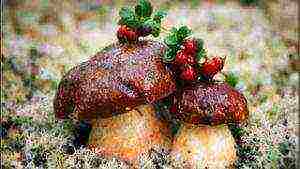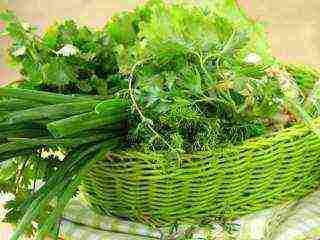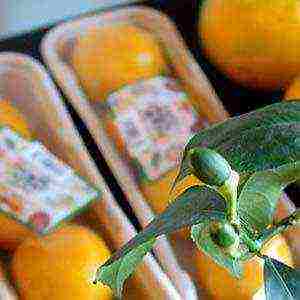Content
- 1 Landing features
- 2 Compatibility with other summer crops
- 3 How to choose a material?
- 4 How much is needed for sowing per 1 hundred square meters?
- 5 Time of work
- 6 What tools are used?
- 7 All about how to plant in open ground
- 8 Is it possible and how to properly grow from seeds?
- 9 How should a germinated root be rooted?
- 10 Step-by-step instruction
- 11 Possible problems and difficulties
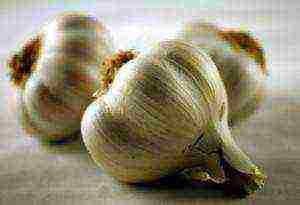
Garlic
How many years in a row can you grow garlic in the same place?
Experience suggests: garlic is placed extremely tightly (40-50 plants per 1 m2) in order to save space for other crops. You can grow garlic in one place for no more than two years. Otherwise, contamination of the soil with stem nematode cannot be avoided. It is better to start garlic after cucumber, early potatoes, early cabbage and other early-harvested crops (except for onions).
Many gardeners are upset that for many years, planting garlic, they can not achieve a good result. The bulbs are small, a lot of them disappear during growth or at the time of harvest. In years with hot summers, garlic often has to be watered, which negatively affects the preservation of the bulbs. And without watering, the garlic turns yellow and dries up. If the summer is rainy, the garlic rots. Even during storage it dries up, deteriorates, although it is placed in a dry place. How to be?
The lack of harvest of garlic in this case can be explained by such reasons. First of all, you should not allow garlic to be cultivated in one place for many years, because the soil can be infected with a nematode. Another reason: during the growing season, plants are shaded by trees, shrubs or buildings. It happens that water has a high salt content. This is also the reason. If the garlic for planting was brought from distant places, then it quickly degenerates, and in this case the seed material must be completely changed.
It is appropriate to recall that garlic loves fertile, well-fertilized soil. It is picky about soil moisture, especially when critical periods of its growth and development come: during the germination of cloves (the first two weeks after planting), increased leaf growth, and also at the beginning of cloves formation. With a lack of moisture during these periods, the bulbs are small. During the growing season, garlic needs watering. Watering is stopped 20-25 days before harvesting. Excessive nitrogen fertilization has a negative effect on product storage. It is not at all suitable to bring them in at the beginning of the formation of the bulb, when they are frequently watering. Garlic grown for long-term storage, after trimming the leaves, dry thoroughly in the sun until it rustles when transferring.
R. Nedbal
When is the best time to plant winter garlic varieties?
For winter garlic, the ridges are prepared a month before planting. A bucket of humus or compost is applied to the first beds, 1 tbsp is used from mineral fertilizers. a spoonful of double superphosphate, 2 tbsp. tablespoons of potassium sulfate, 2 cups of wood ash. A plot is dug to a depth of 20-25 cm, then it is harrowed, watered and left until the garlic is planted.
Before winter, garlic is usually planted from September 5 to October 1. Plants with such planting dates have time to take root well, tolerate wintering better, use soil nutrients, autumn and spring moisture better. In spring, plants grow and develop earlier and more intensively. With a later autumn planting, the number of frozen plants increases, the growing season is significantly lengthened. Inflorescences, bulbs, bulbs are smaller, they ripen worse, the yield decreases.
How to plant?
Garlic is planted with five row ribbons with a distance between rows of 20 cm, between plants 6-8 cm.The depth of their incorporation is also different - from 5 to 8 cm. Deep planting of large cloves and one-toothed teeth in autumn contributes to the rapid rooting of plants and their preservation from freezing. After planting the garlic, the soil is mulched with humus or peat with a layer of 2-3 cm.If the autumn is dry, then in order for the garlic to take root better, it is watered at the rate of 10-12 liters per 1 m
How many years in a row can you grow garlic in one place?
Experience suggests: garlic in one place should be grown for no more than 2 years. Otherwise, contamination of the soil with stem nematode cannot be avoided. It is better to start garlic after cucumbers, early potatoes, early cabbage and other early-harvested crops, except for onions.
Why does garlic fail?
The lack of harvest of garlic can be explained by a number of reasons:
1 First of all, you should not allow garlic to be made in one place for many years.
2 During the growing season, the plants are shaded by trees, biters or buildings.
3 It happens that water has a high salt content.
4 If the garlic for planting was brought from distant places, it quickly degenerates, and in this case, completely change the seed material.
5. It is pertinent to recall that garlic loves fertile, well-fertilized soil. It is picky about soil moisture, but watering is stopped 20-25 days before harvesting.
How to renew the seed?
In mid-May, soak small cloves of winter garlic that are not suitable for autumn planting in a warm RIGHT_BRACKET (40-45 ° C) weak solution of potassium permanganate and keep for 6-7 hours.
Plant the cloves in the beds between carrots and peppers at a distance of 6-7 cm between the cloves and the cloves. In two weeks the garlic will sprout together. Subsequently, the heads grow out of the cloves 2-5 cm in diameter. You can start digging when the stem begins to turn yellow at the bottom. Dry. And plant this renewed planting material in the fall, as usual.
Stingri aizliegts DELFI publicētos materiālus izmantot citos interneta portālos, masu informācijas līdzekļos vai jebkur citur, kā arī jebkādā veidā izplatīt, tulkot, kopēt, reproducēt vai kā citādi rīkoties ar DELFI publicētajiem materiāliem bez rakstiskas DELFI atļaujas saņemšanas, bet, ja atļauja ir saņemta, DELFI ir jānorāda kā publicētā materiāla avots.
1. Garlic is placed extremely densely (40-50 plants per 1 m2) in order to save space for other crops. You can grow garlic in one place for no more than two years. Otherwise, contamination of the soil with stem nematode cannot be avoided. It is better to start garlic after cucumber, early potatoes, early cabbage and other early harvested crops (except for onions).
2. Many gardeners are upset that for many years, planting garlic, they can not achieve a good result. The bulbs are small, a lot of them disappear during growth or at the time of harvest. In years with hot summers, garlic often has to be watered, which negatively affects the preservation of the bulbs. And without watering, the garlic turns yellow and dries up. If the summer is rainy, the garlic rots. Even during storage it dries up, deteriorates, although it is placed in a dry place. How to be?
3. The lack of harvest of garlic in this case can be explained by such reasons. First of all, you should not allow garlic to be cultivated in one place for many years, because the soil can be infected with a nematode. Another reason: during the growing season, plants are shaded by trees, shrubs or buildings. It happens that water has a high salt content. This is also the reason. If the garlic for planting was brought from distant places, then it quickly degenerates, and in this case the seed material must be completely changed.
4. It is appropriate to recall that garlic loves fertile, well-fertilized soil. It is picky about soil moisture, especially when critical periods of its growth and development come: during the germination of cloves (the first two weeks after planting), increased leaf growth, and also at the beginning of cloves formation. With a lack of moisture during these periods, the bulbs are small. During the growing season, garlic needs watering. Watering is stopped 20-25 days before harvesting. Excessive nitrogen fertilization has a negative effect on product storage. It is not at all suitable to apply them at the beginning of the formation of the bulb, when they are frequently watering. Garlic grown for long-term storage, after trimming the leaves, dry thoroughly in the sun until it rustles when transferring.
published on according to the materials dachnyj-sad-
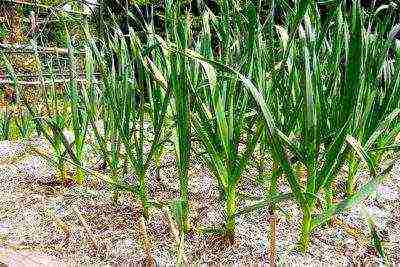 The responsibility for the success of garlic cultivation lies most of all with the properly organized planting of the plant.
The responsibility for the success of garlic cultivation lies most of all with the properly organized planting of the plant.
Here you not only need to choose high-quality seed, but also know all the subtleties and features of planting a vegetable crop.
The article will help you figure out how to choose the right seed and with which crops it is better to plant garlic so that it grows better. We will also figure out how to deal with possible difficulties in growing.
…
Landing features
The planting of garlic depends on several determining factors. Consider the features of planting this vegetable crop:
- Garlic varieties have two large groups - spring and winter. They differ in properties and planting methods. Spring garlic is moderately hot, contains up to 25 teeth in the head, the shaft is soft. It is famous for keeping quality, it is planted in spring. Winter crops have large teeth, a dense core. Gives big yields, which fall at the time of home harvesting. Planted in the fall. Not stored for a long time.
- Planting garlic depends on the climatic conditions of the area. Early snowfalls will help warm the crops, the need for shelter will disappear, in the northern regions it is imperative to shelter.
- Planting agrotechnics include: compliance with crop rotation, planting dates, the presence of a sunny site, loamy soil, not using fresh manure, pre-sowing work, mandatory mulching when planting before winter.
- To get a large amount of high-quality planting material, bulb seeds of arrow-headed varieties are used.
Compatibility with other summer crops
When planting garlic, you need to consider compatibility with other vegetable crops. It is possible to identify the main groups of plants that for garlic will be:
- Compatible - carrots, cucumbers, parsley, potatoes, salads, tomatoes, beetroot.
- Incompatible - beans, beans, peas, cultivated parsnips.
How to choose a material?
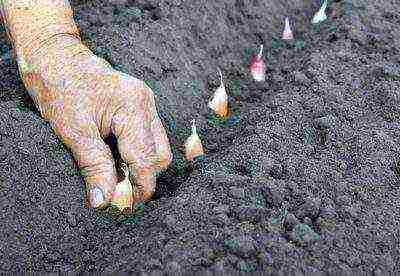 Garlic for planting is carefully selected - the future harvest depends on the planting material: Teeth, bulbs and one-tooth should be:
Garlic for planting is carefully selected - the future harvest depends on the planting material: Teeth, bulbs and one-tooth should be:
- Healthy, dense, not damaged by pests or diseases.
- Not overdried, not rotten.
- Medium size, or large (bulbs not less than 0.3 cm).
Choose from varieties of garlic for planting - purple with stripes. It is unpretentious and frost-resistant, stored for up to 9 months, heads weigh up to 150 g.
How much is needed for sowing per 1 hundred square meters?
The amount of garlic per 1 hundred square meters depends on the planting scheme. If you leave between the beds - 40 cm, and between the bushes - 20 cm, then about 350 heads will go to a hundred square meters, or from 10 to 13 kg of garlic with large heads, and - 7 kg if one-toothed. Seeding rate of seeds (bulbs) - 200 g per 10 m2.
Time of work
The timing of planting garlic depends on the following factors:
- Climatic zone. In some areas, the plant is planted twice a year: in spring and autumn (before winter). The air temperature should be up to + 10 ° С. In the south, it is November, in temperate latitudes starting in September. Before frost should be at least two weeks. The root system should develop, but the sprout has not yet appeared. Otherwise, the plant will not overwinter.
- Embedding depth. If planted to a depth of 20 cm, then it is more advisable to plant at the end of the summer period, and to provide care in the fall. When planting (up to 8 cm) - two weeks before stable frosts.
- Varieties. A winter vegetable is planted in autumn, a spring vegetable in spring.
Sometimes gardeners use the lunar or sowing calendar for a year to calculate the exact date of planting a vegetable crop.
What tools are used?
There are various attachments for planting vegetables. A smart choice will make the job easier. Garlic planting tools:
- Manual garlic planter. It is a simple, economical mechanism that is transported and adjusted by hand. It will suit those gardeners whose possessions are not large.This mechanism must maintain a straight line when planting, deepen the soil to the desired depth, and place the tines evenly.
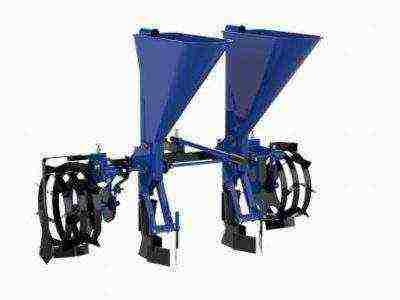 Seeder for garlic. A device that makes the planting process less laborious. Effective for large amounts of land given over to garlic. The soil is pre-prepared by leveling. The principle of operation is that the opener cuts grooves into which the seeds are placed. Then the openers cover the teeth with soil and huddle the beds.
Seeder for garlic. A device that makes the planting process less laborious. Effective for large amounts of land given over to garlic. The soil is pre-prepared by leveling. The principle of operation is that the opener cuts grooves into which the seeds are placed. Then the openers cover the teeth with soil and huddle the beds.- Seeder with mini tractor. Greatly reduces the time spent on work, but requires a lot of fuel consumption. Packing rollers help complete the planting process. The ability to use cloves and "bulbs" as planting material.
- Homemade garlic planter. A step is welded to a metal pipe. To form a hole in the ground, you should put your foot against the step and press on it. A clove of garlic is placed in the resulting hole and covered with soil mixed with ash.
All about how to plant in open ground
At home, as well as in the open field, winter and spring varieties are used for planting garlic. But the difference is that in the first case, garlic is planted at any time of the year, creating artificial optimal conditions for the growing season. In the spring, boxes with crops are kept on glazed balconies and window sills.
Unlike at home, when planting garlic in open ground, the plant should be planted in such a way that it does not have time to germinate before frost and die. Then, as at home, you can control the planting process: Place the boxes with the sown garlic in a bright, cool room with an optimal temperature.
The difference in caring for planted garlic:
- Vegetable crops are demanding on soil moisture. At home, the plant needs to be watered rarely, but abundantly, since the soil in pots (due to its small volume) dries out faster than in the garden.
- When planting garlic in containers, the soil should be well fertilized with humus, liquid or granular flower dressings. Since the root system of the plant, the potted soil quickly depletes.
Is it possible and how to properly grow from seeds?
In addition to cloves and one-toothed garlic, you can plant garlic using seeds (bulbs), which the arrowhead plant varieties form on the flower stems.
There are the following planting methods:
- Growing a plant in seedlings with transplantation. The principle is that the seedlings are planted in the same year before winter, or next spring. Then he is transplanted to a new place.
- Seedless. In this way, garlic is grown by planting seeds in the soil. If the garlic is winter, then full-weight cloves, one-toothed bulbs and bulbs are used. It will take two seasons to grow a ready-made bulb from a bulb, and one from a clove. Bulbules with this method are not dug out, leaving to overwinter. A year later, a larger onion is taken out at this place.
You need to choose a planting method based on the climatic conditions of the area, the availability of planting material, and variety.
How should a germinated root be rooted?
Garlic sprouted in spring can be planted in the garden both in April and in May. By the fall, large bulbs (one-toothed) will appear. They can be left in the ground (harvest next year), or dug up and used as seed.
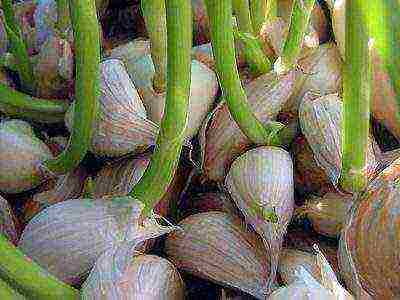 Planting sprouted garlic at home in boxes is as follows:
Planting sprouted garlic at home in boxes is as follows:
- Go through the heads, remove the unusable ones.
- Divide into parts, discarding diseased teeth.
- Trim dry roots carefully.
- Soak the sprouted teeth in a 0.5% solution of potassium permanganate for 2-3 hours. Solution temperature up to 40 ° С.
- Plant the softened and disinfected cloves in a container, in which to fill the garden soil to the bottom.
- Water the plants in moderation before getting wet.
- Before rooting, the boxes of garlic should be removed to a cool place (no more than + 12 ° C).
Step-by-step instruction
What is the soil and sowing depth?
If it is possible to prepare the site in advance, then it is better to do this a month or one and a half before planting. Fertile loamy soils are suitable for garlic crops, acidity is neutral. Salt marshes and acidic soils, places with stagnant water should not be taken away for garlic.
Soil preparation is as follows:
- The site is thoroughly cleaned of weeds.
- If fertilizers were not applied under the predecessors, then a month before planting, scatter humus (4-5 kg / sq. M), mixed with wood ash (1 glass). Fertilize with superphosphate, potassium salt before sowing.
- On the eve of planting (12 - 14 days), thoroughly dig up the soil. Depth - shovel bayonet.
- Cover the dug up place with foil.
Inventory
To plant garlic, you will need the following tools:
- bayonet shovel;
- rake;
- hoes;
- manual flat cutter;
- pitchfork;
- buckets;
- watering can;
- Divide the heads into separate cloves, calibrate, choosing large ones - they will give a more powerful harvest.
- Discard sick and damaged ones, carefully examine the bottoms for the presence of a root system.
- Disinfect.
- Dry.
Attention. If the bottom is separated from the cloves, then rooting will take place faster, but it is not necessary to peel the garlic from the external dry parts.
There are several ways to disinfect planting material:
- soak in a weak solution of potassium permanganate or copper sulfate for a day;
- treat with an ash-alkaline or saline solution;
- soak for two hours in 40% formalin solution;
- treat with Totril herbicide, to increase immunity and prevent weed growth;
- warm the cloves for 15-20 minutes in hot water or (40C) for the prevention of fungal diseases.
Preparing bulbs for planting:
- At the moment when the covers on the peduncles open, gently pull the plants out of the soil along with their heads.
- Shake off the ground, tie to dry in a cool place with the roots upwards.
- After drying, carefully remove the bulbs.
- Select dense bulbs with a diameter of at least 3 mm.
Bulbules are used to heal seed material. Otherwise, garlic may degenerate in 4-5 years.
Watch a video on how to properly prepare and process garlic before planting:
Seat selection
You should choose a dry, well-lit place. The predecessors can be green manure, legumes and melons. These vegetable crops saturate the soil with mineral elements, which has a beneficial effect on the growing season of garlic. It is undesirable to plant after potatoes, as they deplete the soil.
It is not recommended to re-grow garlic in the same area, the interval should be at least 4 years. After harvesting, the place needs to be changed.
Diagram of how to form ranks
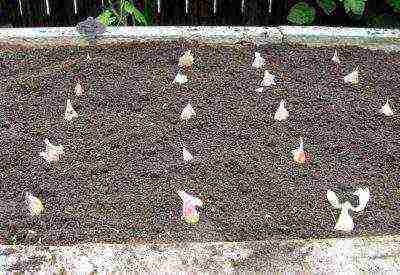 Garlic is planted in rows, leaving wide aisles (40-45 cm) for the formation of high-quality heads. And also to simplify weeding and soil cultivation. The planting pattern of a vegetable crop depends on the size of the seed and the climatic conditions.
Garlic is planted in rows, leaving wide aisles (40-45 cm) for the formation of high-quality heads. And also to simplify weeding and soil cultivation. The planting pattern of a vegetable crop depends on the size of the seed and the climatic conditions.
When choosing the optimal scheme, they are guided by the following criteria:
- Large teeth and one-toothed teeth are planted to a depth of 15 cm, in increments of 15-20 cm.
- For shallow ones, the embedment depth is 6-8 cm, the step is 8 cm.
- For bulbs, the sowing depth is 3-4 cm, the step in the row is 3 cm, in the row spacing - 15 cm.
At a great depth of sowing, the teeth will root more easily, avoid freezing. But with such a deepening, the growth process of garlic is inhibited.
Technology
To get a high-quality harvest, you must follow the rules for planting a vegetable crop. The technology of autumn planting of garlic consists of the following steps:
- The prepared area should be watered first.
- In the prepared place, grooves are formed (the distance in the row spacing, as well as the pitch and depth of planting the teeth are set according to the scheme).
- Pour in clean river sand and ash as drainage.
- Plant the teeth vertically (do not lay on their side).
- Do not water, mulch on top with straw, foliage, sawdust, peat crumb (height 5-10 cm).The mulch should be removed in the spring as soon as the weather is warm so that sunlight can penetrate the sprouts.
- In a snowless winter, cover the beds with roofing material or film, insulate with spruce branches, sawdust.
Consider the main stages of spring planting of garlic:
- The plot is prepared in the fall, compost (5 kg per 1 sq. M), superphosphate (5 g), potassium salt (3 g) are added.
- At the beginning of field work, when the snow melts, there is no threat of frost, garlic (since its root system is formed already at a temperature of + 2 ° C) is prepared for planting.
- The ground is marked by delineating rows with the desired row spacing.
- Lay drainage in the drawn grooves.
- 5. Teeth and one-toothed teeth are planted vertically according to a given pattern.
Bulbules are sown manually or with the help of special seeders according to a given pattern. After completing sowing, I mulch the rows with compost or humus.
When planting, you do not need to press hard or twist the cloves into the soil, otherwise the growth of the roots will slow down, or the garlic will come out.
Further care
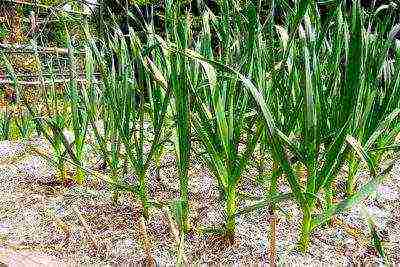 If the vegetable crop has time to take root before the stable cold weather, it overwinters, it will not need special care in the future. In terms of agricultural technology, winter varieties are more demanding, but with proper care, their yield is higher, the heads are larger.
If the vegetable crop has time to take root before the stable cold weather, it overwinters, it will not need special care in the future. In terms of agricultural technology, winter varieties are more demanding, but with proper care, their yield is higher, the heads are larger.
Plant care is as follows:
- Cleaning the beds. With the arrival of spring, remove the protective film, rake out the mulch, with a small layer of surface soil (up to 2 mm), so that it is easier for the shoots to break through.
- Watering. Young plants need to be watered regularly (once every 10 days). From the moment the heads are formed, cut watering. Water more frequently during dry seasons. Vegetable crops do not like over-watering. This can lead to fungal diseases, rotting.
- Loosening. The next day after watering, the garlic needs to be weeded, the soil near the bushes should be loosened
- Top dressing. Vegetable crops respond well to organic fertilizers. With the beginning of the growing season, a solution of wood ash (200 g per 10 l), bird droppings is introduced.
- Removing arrows. In June, the arrowhead plants produce flower stalks. They need to be removed by breaking off. If the arrows are left, then the heads of garlic are formed small, because the flower stems take a lot of energy from the plant. Several plants can be left with seeds for propagation.
- Pest control. Potash and other trace minerals in fertilizers help in pest control. If you water the plant with a yeast solution, then it will saturate the soil with useful substances and increase immunity against fungal diseases. You can treat insects with fugicides.
Attention. With the seedling method of planting, when the first leaves appear, the plants need to be fed with organic fertilizers, when flower arrows appear - with complex mineral fertilizers (3 tablespoons per 10 liters of water).
Ways to get the harvest
There are two effective ways to grow garlic.
How to plant a plant correctly?
- When planting with teeth:
- How to grow seedlings? In the garden, where the garlic grew, bushes appeared in the spring, which grew from the heads that were not dug out during the harvest. They can be planted in a garden bed prepared in the fall. Leaving in the same place for the second year is undesirable. The plant tolerates transplanting well. At the same time, the roots must be slightly trimmed so that they do not bend.
- A reckless way. In this way, garlic is grown by planting seeds in the soil. If the garlic is winter, then use full-weight cloves, one-toothed bulbs and bulbs. It will take two seasons to grow a ready-made bulb from a bulb, and one from a clove. Spring propagates only by denticles.
- When planting in bulbs:
- Seedling method. This method is considered traditional, but labor intensive. The bulbs are sown in rows with an embedment of no more than 1.5 cm.When the foliage is withered, the one-toothed ones are dug out. The calibrated planting material is stored in the cold and planted in the fall.
- A reckless way. The collected bulbs are sown on the beds (every 2-3 cm).They are left for the winter in the same place. The crop is harvested in the fall - one-tooth or heads with 4-5 teeth.
- When planting sprouted garlic:
- Seedling method. Garlic sprouted in spring is planted in the garden beds or at home in pots. In the fall, one-toothed beetles will grow in this place.
- A reckless way. Garlic sprouted in the garden can be left in the same place. But you need to know the arrow turned out from seeds or cloves. If from the cloves, then in the summer such garlic is dug, if from the bulbs, then the harvest is harvested the next year.
Possible problems and difficulties
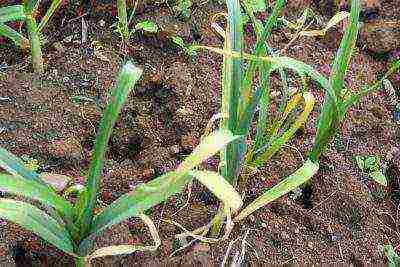 When planting garlic, the following problems may arise:
When planting garlic, the following problems may arise:
- If the plant grows after the autumn planting, it may die from frost.
- If the plant does not have time to take root before frost, then in the future it may rot or freeze.
- It is necessary to ensure that plantings in the spring are not flooded with autumn rains and melt water.
- If the site for planting is infected with fungal infections, then treat the soil with copper sulfate.
Precautions taken during the planting phase can help prevent the following diseases:
- Defeat by rot. This is reflected in the rotting of the bulbs, the death of the root system, the leaves turn yellow. White bloom may also appear on the roots. The choice of a high-quality planting variety and treatment with disinfectants on the eve of planting will help prevent this.
- If garlic plants are affected by onion flies, then treat the bushes with a mixture of wood ash (1 tbsp), tobacco dust (1 tsp) and black pepper (1 tsp). After cultivation, loosen the soil.
- The appearance of nematodes can be prevented during the seed preparation stage by soaking it in saline.
Having familiarized yourself with the technology of planting garlic, and applying it in practice, you can grow a bountiful and healthy harvest already in the next sowing season. The main thing is to accurately observe the planting dates and use high-quality seed.
